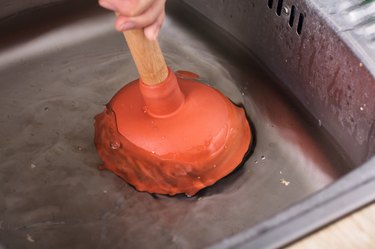
Every home plumbing system consists of pipes that bring water into the house and pipes that take it away. The pipes in the second category form the home's drain-waste-vent (DWV) system. While it's easy to appreciate the role of the drain and waste pipes, the role of the vents may not be as obvious. Without vents, or in the event they become clogged by leaves or debris, water would get stuck in the drain and waste pipes rendering the fixtures useless. You can often clear clogs with a garden hose, but some situations may require a bit more effort.
Structure of the Vent System
Video of the Day
Every toilet and drain in a house is connected to its own vent pipe. These connect to a larger pipe—usually three or four inches in diameter—that extends vertically through the roof, known as a vent stack. In most houses, this pipe extends vertically all the way to the sewer. The one- to two-foot vertical pipe you see on most roof tops is the visible extension of the vent stack.
Video of the Day
Branch lines serve individual fixtures and have diameters between 1 1/4 and two inches. They can run horizontally, as long as they maintain a minimum downward slope (1/4 inch per foot) toward the fixture to prevent water from pooling inside. Sometimes a fixture, such as a sink or shower, has its own 1 1/4- to two-inch vent that extends through the roof.
Symptoms of a Clog
When a vent is clogged, air can't get into the drain pipes, and if you've ever filled a straw with soda and put your finger over one end, you know what happens next. As water tries to flow, it creates suction behind it that stops it altogether. Connected to every drain is a P-trap full of water, and when flowing water creates enough suction, it draws air through the trap. You can usually hear this as a bubbling or gurgling sound coming from the drain. If the suction is strong enough, it draws all the water out of the trap, and since the water is the only thing blocking sewer gases, you'll be able to smell those gases. Additionally, the blocked vent also causes water to move slowly, giving you the impression of a blocked drain.
Clearing the Main Stack
Most clogs occur in the main stack. Sometimes leaves and debris fall into the pipe or birds or other small animals make nests. In the winter, ice can form inside an undersized vent and block it. It isn't safe to climb on the roof to check the vent in the winter, but in the summer months you can clear vent blockages by removing debris from the vent opening. If the blockage is deeper inside, insert a garden hose into the vent and turn on the water. The force of the water should clear the obstruction and the water will continue down the stack to the sewer. If the blockage is stubborn, you may have to clear it with a 20-foot sewer auger.
When a blockage occurs during the winter months and you suspect the issue is caused by ice, you can often clear it by going into the attic with a hair dryer. Locate the vent pipe and point the hair dryer at the section closest to the roof for several minutes. This should melt the ice. If ice-over occurs frequently, consider insulating the pipe or protecting it with heat tape.
Clearing Blockages in Branch Vents
When you notice symptoms of a vent blockage at a single fixture, it's usually because there's a blockage in the branch vent that services it. Branch vents are difficult to access from the roof, but you may have some luck with a fish tape that electricians use to pull wires. However, most cases call for some degree of pipe disassembly, which is fairly straightforward if the pipes are ABS plastic. Find a way to access the vent, then cut it and insert an auger. Push it in until you encounter the obstacle, then continue pushing through. The debris should come out with the auger. When you've cleared the obstacle, repair the pipe by gluing in a coupling. You can use the same technique for cast iron vent pipes found in older homes, although it's more difficult to cut the pipe. After clearing the obstacle, repair the pipe with a flexible rubber coupling with pipe clamps on either end.